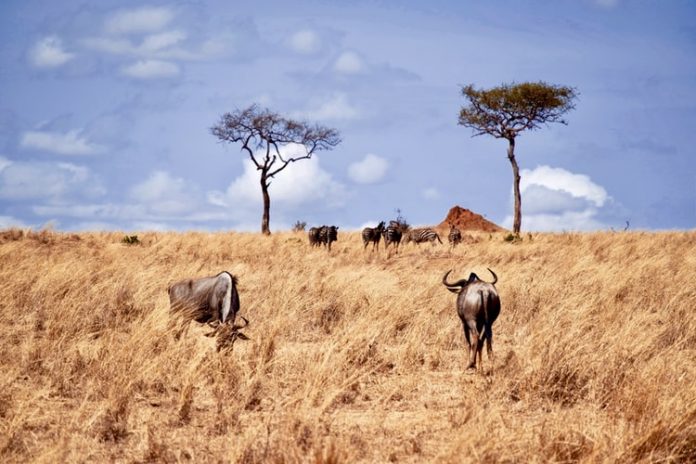A team of researchers from the U.K, Tanzania, South Africa and the United States explored the ecosystem behaviour and population size of the East African wildebeest community in the Serengeti National Park in Tanzania, using a deep learning algorithm to count its population and validate the data through citizen science techniques.
In a paper published on 16 March 2019 in the journal “Methods in Ecology and Evolution”, the researchers, comprising of mathematicians and conservationists from the University of Glasgow, the Tanzania Wildlife Research Institute (TAWIRI), the University of Cape Town in South Africa and the Field Museum of Natural History in the U.S.A, explained how they used deep learning algorithms to accurately count wildebeest in the Serengeti National Park with a system that is more feasible than the use of existing techniques.
The Serengeti ecosystem in northern Tanzania, which spans towards the Masai Mara reserve in Kenya, is a magnificent natural heritage endowed with several terrestrial mammals, fauna and flora. It is one of the Seven Natural Wonders of Africa and one of the Ten Natural Travel Wonders of the World, renowned for its ecological beauty, and particularly, for the presence of the seasonally migrating wildebeest.
“The major driving force in the Serengeti’s ecosystem is the abundance of wildebeest. Currently, there are about 1.3 million wildebeest, and this influences almost every variable in the ecosystem, everything from the return rate of fires – since they eat the grass – to the number of insects that are available, to migrating birds. Without wildebeest, the ecosystem would shift into a completely different state, and therefore it’s important to know how many there are,” said Dr Grant Hopcraft of the University of Glasgow’s Institute of Biodiversity Animal Health & Comparative Medicine, who is a senior author on the paper.
The migration attracts several ecological studies and conservationist activities in an attempt to monitor the herd’s migration trends and ecosystem behaviours. Assessing the wildebeest ecosystem is usually costly, labour and time-intensive, requiring human counts which usually take months to complete.
In this study, the researchers developed a new technology that beats the traditional methods in accuracy and delivery time. They created deep-learning algorithms to recognise wildebeest in images that were captured from the 2015 Serengeti National Park aerial survey.
“The system was ‘trained’ to identify wildebeest using 500 high-resolution aerial images from the Serengeti, then fine-tuned for further accuracy, ultimately being capable of processing 1,000 images in less than two hours and able to produce a total count of over 20,000 wildebeest within 1 percent of a count conducted by a human expert”, according to the research synopsis published on Phys.org
Read also:
- Researchers Use Night-time Satellite Images To Map Access to Electricity In Sub-Saharan Africa
- Conservationists are Using GPS Satellites to Save Giraffe Population Across Africa
- Ghana Is Using Satellite Imagery To Combat Illegal Mining
The team further validated the results from the algorithm by using citizen science techniques, a practice of public participation and collaboration in scientific research. They published 10,000 of the same aerial images on Zooniverse, a citizen science web portal owned and operated by the Citizen Science Alliance, allowing about 2,200 Zooniverse users to count the number of wildebeest in each image. They ensured that 15 different volunteers re-counted each image to guarantee accuracy.
Commenting on the outcome of the research, Dr Colin Torney, senior lecturer at the University of Glasgow’s School of Mathematics and Statistics and one of the paper’s lead authors, said: “Our approach gave us really good results, which I think shows the unique benefits of this type of cross-disciplinary collaboration. Our research suggests deep learning algorithms could support traditional hand-counting methods or, potentially, even replace them entirely as the primary means of processing the aerial photographs.”
The study further corroborates the potentials of emerging technologies in revolutionizing research and improving lives in Africa, as well as helping to preserve the continent’s precious natural heritage.
Dr Edward Kohi, a co-author of the paper and Principal Research Officer at the Tanzania Wildlife Research Institute, said: “These emerging technologies will enable TAWIRI to have an annual wildebeest survey as the time consuming manual work will be taken care of. The success of the machine learning approach represents a major milestone for wildlife survey techniques in Tanzania and across Africa. TAWIRI and our partners take this improvement very seriously and we are planning to apply this advancement to other wildlife species.”
Beyond counting wildebeest population, the team is looking to leverage satellite imageries in expanding its research to broader application scenarios, particularly, in conducting population surveys for wildlife and human population.
“The work we’ve done with deep learning and citizen science is really encouraging, and we’re keen to expand it further in the near future, perhaps for population surveys using satellite imagery. It’s an exciting time for the field, and demonstrates the potential benefits that can be achieved from mathematicians and ecologists working more closely together”, adds Dr Hopcraft
This article is adapted from the Research Sypnosis published on Phys.org






